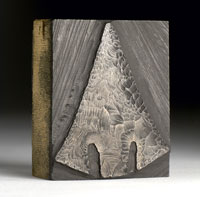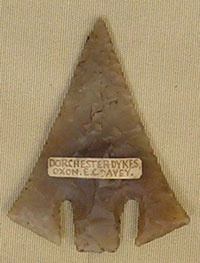Artefact Illustrations
To produce the illustrations for his books, the objects had to be drawn, then engraved or lithographed. John Evans did quite a number of his own illustrations and F.W. Fairholt, then Charles Swain, produced the engravings. Mr. Fairholt 'used to come to stay at Nash Mills for long spells of work and have his bad cough kindly dosed by Fanny' (Time and Chance). It was a very personal business. After he died Mr. Swain from Bouverie Street, London was engaged to produce them; he did not come to Nash Mills to execute the engravings; instead the objects had to be sent up to him in London on the train, where he employed a team of engravers. The publications and their drawings were produced by Evans following long days of work in the mills or at Dickinson's London office. There are 540 illustrations of celts, palstaves, sickles, daggers and swords in The Ancient Bronze Implements. |
|||||
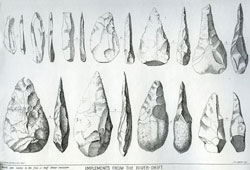 |
Plate I from the revised second edition of The Ancient Stone Implements, Weapons and Ornaments of Great Britain written by Evans in 1897. Evans commissioned the drawings. |
||||
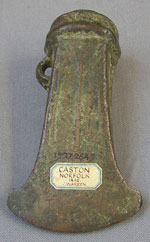 This is the axe-head illustrated on the right of the page in The Ancient Bronze Implements. It is from Caston, Norfolk (AN1927-2649) |
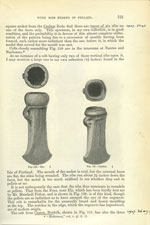 Page from The Ancient Bronze Implements, Weapons and Ornaments of Great Britain and Ireland. AN1927.2649 is illustrated on the right. |
As with a number of the stone and flint implements, we believe Evans did some working drawings of the bronze objects. |
|||
|
|||||
Further References / Links:John Evans, The Ancient Bronze Implements, Weapons and Ornaments, of Great Britain and Ireland (1881) John Evans, The Ancient Stone Implements, Weapons and Ornaments, of Great Britain (2nd edn. 1897) Joan Evans, Time and Chance: The Story of Arthur Evans and His Forebears (1943) See also the chapters by Brendon O'Connor and Assimina Kaniari in Sir John Evans 1823-1908, edited by Arthur MacGregor (2008) |
|||||

